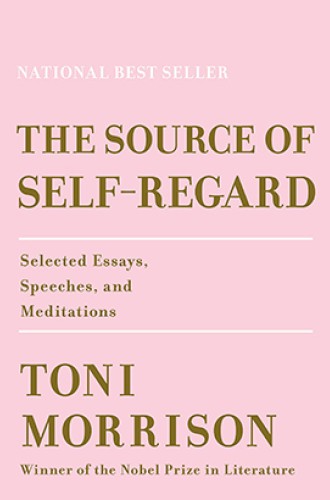Toni Morrison writes about race, religion, and her own fiction
Our language isn’t neutral. It has history embedded within it.
Toni Morrison’s collection of nonfiction makes a striking contribution to American letters and to an understanding of her own rich and complicated fiction. Gathering speeches and essays from 1976 to 2011, the volume gives us several decades of her thought—and its evolution—to contemplate.
African Americans, Morrison observes, have the peculiar circumstance of being considered foreign in their own country. From a very early moment in American history, identity and race became intertwined. Blackness became associated with a criminalized underclass while whiteness was counterposed as representing citizenship and freedom. These loose but deeply rooted structures are perpetuated in contemporary media in a way that creates linguistic problems for writers and social concerns for all of us.
For example, Morrison wants to give voice to racial identity that doesn’t perpetuate racial stereotypes or hierarchies. But this is much easier said than done, given that blackness and whiteness are labels invented for the very purpose of organizing stereotypes and hierarchies. “We hunger for a way to articulate who we are and what we mean,” she writes. But the language we’ve all inherited is not neutral. It has history embedded within it.
Morrison is fascinated by the way that American literature written by white people has so often been preoccupied with the presence of black people and yet refuses to address it directly. Blackness has been a blank space onto which white people have projected their fears, dreams, and fantasies. For example, when white Americans talked about freedom in the 19th century, slavery was the obvious context through which they understood their own freedom—and yet often they simply didn’t mention it.
When they did mention it, even stranger things happened. At the end of Mark Twain’s Huckleberry Finn, Huck and Tom subject Jim to humiliation that is “baroque, endless, foolish, mind-softening,” Morrison notes, “and it comes after we have experienced Jim as an adult, a caring father, and a sensitive man.” At the end of the day, Huckleberry Finn “simulates and describes the parasitical nature of white freedom.” Huck and Tom can’t set Jim free because if they did, then he couldn’t serve as a foil for their own freedom. Twain’s book is an elaborate and twisted display of white power.
The book is also rich in insights into Morrison’s own fiction. She reflects on the moment when she decided to take on the question of how to create a race-specific language that isn’t charged with racial stereotypes. She sees that “eliminating the potency of racial constructs in language” is work that she, as a fiction writer, can do. She talks about creating this language as if she were rebuilding a house:
If I have to live in a racial house, it was important at least to rebuild it so that it was not a windowless prison into which I was forced, a thick-walled impenetrable container from which no sound could be heard, but rather an open house, grounded, yet generous in its supply of windows and doors.
The book also hints at Morrison’s interest in speaking a language of faith that isn’t hackneyed or presumptuous. In her 1993 Nobel address, she notes that language pushes toward what can’t be said. Language’s “force, its felicity is in its reach toward the ineffable.”
In her fiction, Morrison tries to enter the lives of people whose inner life she cannot know. Beloved imagines the inner life of a slave woman who chose to kill her own child rather than return the child to slavery. Slave women’s inner lives were rarely recorded—they didn’t leave diaries or written records—so Morrison finds herself fundamentally blocked. The only way through the block is to experiment with a language haunted by unspoken things.
A similar dilemma pertains to religious language. Morrison writes about a photograph taken in the early 20th century of members of a religious organization standing in front of a church. The women are all dressed beautifully and look at the camera as if they know the camera is admiring them. Morrison recognizes that these women have a life and a vocabulary of faith that she has no access to. She begins to wonder how to do two things simultaneously: access their language of faith and communicate it to a jaded contemporary public in a way that is not dismissive.
Is it possible to write religion inflected prose narrative that does not rest its case entirely or mainly on biblical language? Is it possible to make the experience and journey of faith fresh, as new and as linguistically unencumbered as it was to early believers, who themselves had no collection of books to rely on?
These questions would be almost utopian—a living language of faith that looks forward instead of backward—if the form they took in Morrison’s fiction wasn’t so sharp it could make you bleed.
At the end of the day, the source of self-regard remains mysterious. Human beings are dignified, Morrison suggests, by forces far beyond the social, far beyond the circumstances into which they are born.
There were moments reading this book in which I wanted to stand up and start singing, moments when I felt washed in a beautiful light, as if someone were using language to transform me, and moments when I was grateful that someone was speaking to me just the way I wish to be spoken to—with precision and artistry and a depth just beyond my reach. I hope The Source of Self-Regard will be read outside of graduate schools. It is a priceless record of an original thinker’s attempt to grapple with some of the hardest and most intractable questions of our time, of language, and of the human condition.
And a special treat: Morrison’s reading of Herman Melville’s white whale.
A version of this article appears in the print edition under the title “Writing the unspeakable."







